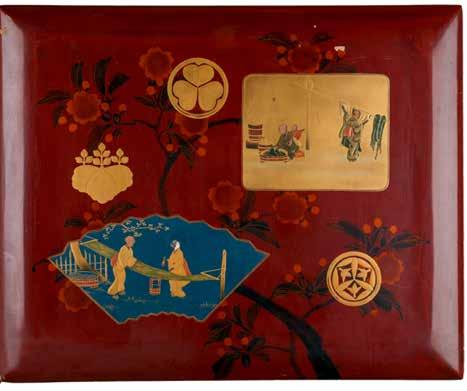Samurai as an export commodity
Jennifer Harris
For over two hundred years, foreign powers had been excluded from Japan, the exception being Dutch and Chinese traders, who were confined to Nagasaki. Japanese travel abroad was forbidden and foreign ships were refused entry into all Japanese ports, even in emergencies. In 1853 Commodore Matthew Perry (1794–1858) challenged Japan’s sovreignty by demanding that United States whaling ships in distress be granted rights of entry. Although the shogun tried to ignore the demands, Perry returned a year later and insisted that a treaty be signed to ‘open’ Japan’s ports for trade and humanitarian access. Intimidated by Perry’s flotilla of ‘black ships’, the shogunate capitulated and signed the Treaty of Kanagawa, in 1854. While this was a victory for the West, it was deeply resented in Japan and ultimately marked the beginning of the end of the shogun’s power and of samurai culture. Other foreign powers insisted that they too be accorded the same rights and in 1858 the number of ‘treaty ports’ that could be accessed by foreigners expanded. By the 1870s Japan had become a tourist destination for wealthy travellers. Foreign passengers usually disembarked in Yokohama, which, catering for the tourist market and encouraged by Meiji government incentives to produce goods for export, had become a centre of souvenir production. For tourists, photographic images were important. While foreign photographers such as Felice Beato (1832–1909) and Baron Raimund von Stillfried (1839–1911) were early pioneers of commercial photography in Yokohama, photography in Japan had an earlier history, having been encouraged by daimyo prior to the fall of the shogunate. For example, Lord Shimazu Nariakira (1809–1858), of the Satsuma domain, had purchased daguerreotype equipment and ordered his retainers to study the techniques as early as 1849.1 By the time tourism had become an industry in Yokohama, numerous Japanese photographers had set up professional photographic studios. Kusakabe Kinbei (1841–1932) specialised in producing rich, lacquercovered albums for foreign consumption, these containing hand-coloured photos of Japanese views and costumes. The covers of the albums depicted exotic images and designs removed from their historical or cultural contexts. The cover of Untitled album is a good example (fig. 1). Placed over a background of cherry blossoms are two cartouches showing kimono-clad women weaving, dyeing and applying patterns to textiles.2 For additional artistic effect, prestigious mon (family crests) of old samurai 72
1 Terry Bennett, Photography in Japan 1853–1912, Tuttle, Tokyo, 2006, p. 35. 2 Kusakabe Kinbei came from a family of textile merchants (Bennett, p. 205).

















